![]()
![]()
![]()
Use LEFT and RIGHT arrow keys to navigate between flashcards;
Use UP and DOWN arrow keys to flip the card;
H to show hint;
A reads text to speech;
52 Cards in this Set
- Front
- Back
|
Hip Pelvis |
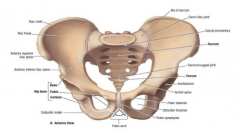
Hip Pelvis • Comprises of: Left and right pelvic bones • Contains four joints • Offers protection of the intestinal tract, urinary tract, internal genital organs • Link between the spine and lower limb |
|
|
Sacrum |
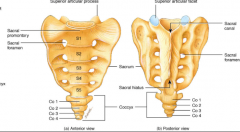
Sacrum • Five fused sacral vertebrae (S1 → S5) • Anterior surface concave, posterior surface convex • Articulates with the lumbar vertebrae (L5), pelvic bones, |
|
|
coccyx |
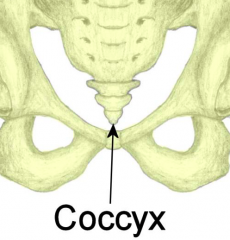
Coccyx: • Four fused coccygeal vertebrae • No vertebral arch or canal • Bears weight during sitting (leaning backwards) |
|
|
Pelvic bones |
Pelvic bones • Ilium • Superior • Pubis • Anterior (inferior) • Ischium • Posterior (inferior) |
|
|
Ilium |
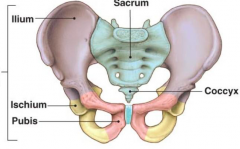
Ilium
|
|
|
Ischium |
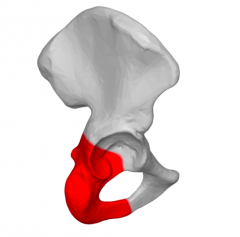
Ischium
|
|
|
Pubis |
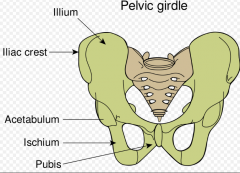
Pubis
|
|
|
Lumbosacral joint |
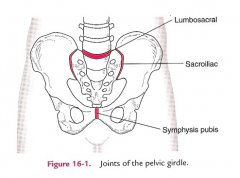
Lumbosacral joint Articulation between the lumbar vertebrae (L5) and superior aspectof the sacrum (S1) • Two (2) zygapophysial joints • Intervertebral disc • Supported by the iliolumbar and lumbosacral ligaments • Flexion (limited)/extension, side flexion |
|
|
Sacrococcygeal joint |
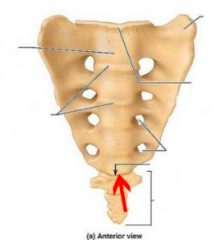
Sacrococcygeal joint • Articulation between the sacrum (S5) and coccyx • Supported by the anterior and posterior sacrococcygeal ligaments • No movement offered |
|
|
Sacroiliac joint |
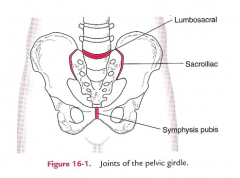
Sacroiliac joint • Articulation between the lateral aspect of the sacrum and iliac bones • Supported by the anterior, interosseous and posterior sacroiliac ligaments • Helps to transmit forces between the spine and lower limb • Offers limited motion |
|
|
Pubic symphysis |
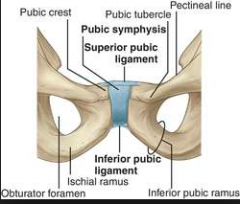
Pubic symphysis
• Articulation between the two pubic bones with a fibrocartilaginous disc between
• Supported by the superior and inferior pubic ligaments
• Allow sliding and gliding movements |
|
|
Orientation of the pelvis |
Orientation of the pelvis • Pubic symphysis and anterior superior iliac spine in the frontal plane • Frontal plane (unilateral stance) • Pelvic hike • Pelvic drop • Sagittal plane • Anterior pelvic tilt • Posterior pelvic tilt |
|
|
Hip joint |
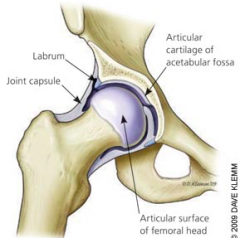
Hip joint
• Articulation between the head of the femur and the acetabulum of the pelvis
• Ball and socket synovial joint
• Transmits forces from upper body to lower limb (standing)
• Stability > mobility |
|
|
Proximal femur |
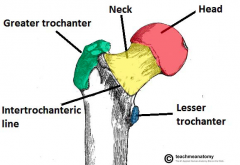
Proximal femur • Head of femur • Neck of femur • Greater trochanter • Lesser trochanter • Trochanter fossa • Intertrochanteric line • Quadrate tubercle • Gluteal tuberosity |
|
|
Acetabulum |
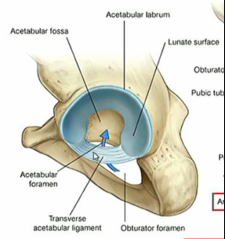
Acetabulum • Lunate surface Articular surface (hyaline cartilage) Thickest at superior aspect • Acetabular fossa • Non-articular • Ligament of head of femur • Acetabular notch • Pathway for blood vessels and nerves • Labrum • Transverse acetabular ligament |
|
|
Articular surfaces |
Articular surfaces Head of the femur Acetabulum of the pelvis • Lunate surface (articular cartilage thickest superiorly) *Acetabular fossa → fovea (head of femur) • Fibrous membrane |
|
|
Ligaments |
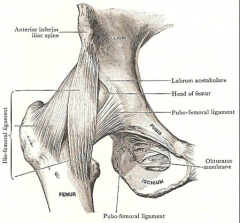
Ligaments Iliofemoral ligament Pubofemoral ligament Ischiofemoral ligament • Tension during hip extension • Stability during standing (reduced energy expenditure) |
|
|
Blood supply and innervation |
Blood supply and innervation
Obturator, medial and lateral circumflex, superior and inferior gluteal arteries and the first perforating branch of the deep artery of the thigh
Femoral, obturator, superior gluteal nerves and the nerve to quadratus femoris |
|
|
Motion |
Motion Flexion and extension • Abduction and adduction • Internal and external rotation • Circumduction |
|
|
Anterior compartment |
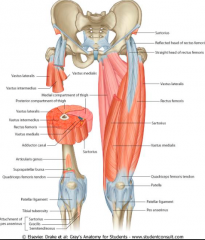
Anterior compartment
• Comprises of seven (7) muscles
Posas major
Illiacus
Sartorius
Rectus fermoris*
Vastus medialis*
Vastus lateralis*
Vastus intermedius*
• Psoas major and iliac strong hip flexors •Sartorial and rectus femoris also contributes to hip flexion
*covered in knee lecture |
|
|
Psoas major |

Origin T12→L5 vertebrae/IV discs Insertion Lesser trochanter Action Hip flexion Innervation Anterior rami |
|
|
Iliacus |
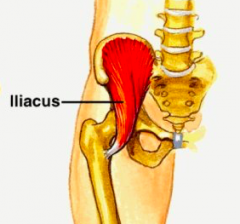
Origin Iliac fossa Insertion Lesser trochanter Action Hip flexion Innervation Femoral nerve |
|
|
Rectus femoris |
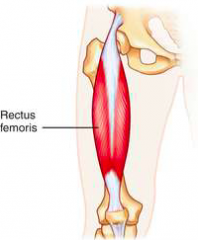
Origin SH: AIIS RH: Ilium
Insertion Quadriceps tendon
Action Hip flexion, Knee extension
Innervation Femoral nerve
|
|
|
Sartorius |
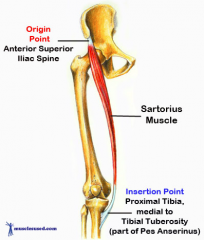
Origin ASIS
Insertion Medial surface of tibia (pes anserinus)
Action Hip flexion Knee flexion Abduction External rotation
Innervation Femoral nerve
|
|
|
Posterior compartment |

Posterior compartment • Contains three (3) muscles; 1. Biceps femurs (long head and short head) 2. Semitendinosus 3. Semimembranosus • All three cross the hip and knee joints • Short head of biceps femurs only crosses the knee joint • Knee flexion and hip extension • Also contribute to rotation at the knee and the hip joints |
|
|
Biceps femoris |
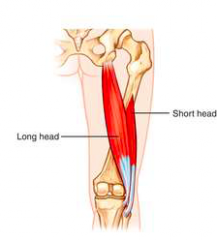
Origin LH: ischial tuberositySH: linea aspera
Insertion Head of fibula
Action Hip extension, Knee flexion, External rotation of leg
Innervation Sciatic nerve (L5, S1, S2)
|
|
|
Semimembranosus
|
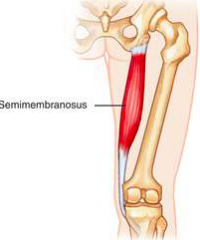
Origin Ischial tuberosity
Insertion Medial surface of proximal tibia
Action Hip extension, Knee flexion, Internal rotation of leg
Innervation Sciatic nerve (L5, S1, S2) |
|
|
Semitendinosus |
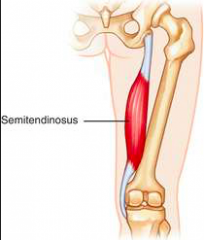
Origin Ischial tuberosity
Insertion Medial surface of tibia (pes anserinus)
Action Hip extension, Knee flexion, Internal rotation of leg
Innervation Sciatic nerve (L5, S1, S2) |
|
|
Medial compartment |
Medial compartment six (6) muscles;
• Adduction of the hip |
|
|
Adductor longus |
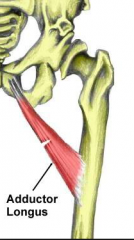
Origin Pubic body just below the pubic crest
Insertion Middle third of linea aspera
Actions Adduction of hip, flexion of hip joint
Deep femoral artery Nerve anterior branch of obturator nerve
|
|
|
Adductor brevis |
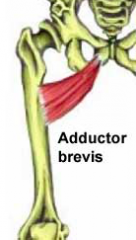
Origin Body of pubis Inferior pubic ramus Insertion Upper 1/3 linea aspera Action Hip adduction Internal rotation Innervation Obturator nerve |
|
|
Adductor magnus |
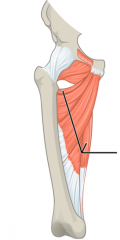
Origin Ischiopubic ramus Ischial tuberosity Insertion Line aspera Medial supracondylar line Adductor tubercle Action Hip adduction Internal rotation Innervation Obturator and sciatic nerves |
|
|
Gracilis |

Origin Body of pubis Inferior pubic rams
Insertion Medial surface of tibia (pes anserinus)
Action Hip adduction, Knee flexion
Innervation Obturator nerve
|
|
|
Pectineus |
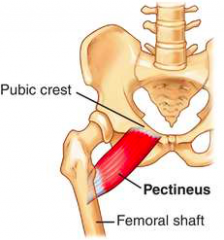
Origin Pectineal line Insertion Lesser trochanter Linea aspera Action Hip adduction Hip flexion Innervation Femoral nerve |
|
|
Obturator externes |
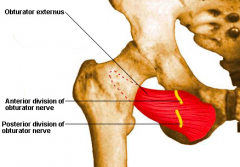
Origin Obturator membrane Insertion Trochanter fossa Action External rotation Innervation Obturator nerve |
|
|
Gluteal region |
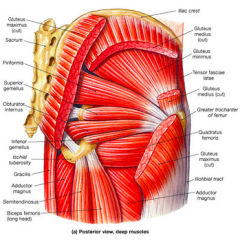
Gluteal region
• Superficial group contains four (4) muscles; Gluteus maximus
Gluteus medius
Gluteus minimus
Tensor fascia later
• Hip extension and abduction
• Deep group contains five (5) muscles; Piriformis
Gemellus superior
Gemellus inferior
Obturator interns
Quadrates femoris
• External rotation |
|
|
Gluteus maximus |
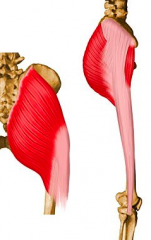
Origin Surface of posterior gluteal line, sacrum, coccyx Insertion Iliotibial band Gluteal tuberosity Action Hip extension Hip abduction External rotation Innervation Inferior gluteal nerve |
|
|
Gluteus Medius |

Origin Gluteal surface of ilium
Insertion Greater trochanter
Action Hip abduction Internal rotation
Innervation Superior gluteal nerve
|
|
|
Gluteus minimus |
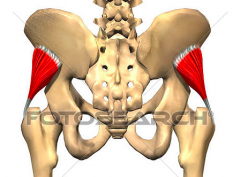
Origin Surface between anterior and inferior gluteal lines Insertion Greater trochanter Action Hip abduction Internal rotation Innervation Superior gluteal nerve |
|
|
Tensor fascia latae |

Origin Surface between iliac crest and ASIS
Insertion Iliotibial band
Action Provides stability to the knee flexes hip, abducts, medially rotates, knee lat. rotation
Innervation Superior gluteal nerve
|
|
|
Iliotibial band |
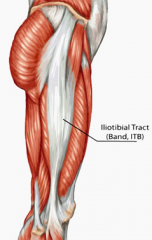
Iliotibial band • Originates at the iliac tubercle • Inserts into the lateral tibial condyle • Provides stability during knee extension • Common site of pain in runners |
|
|
Deep group Piriformis
|
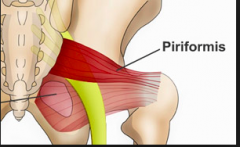
Origin Anterior sacrum
Insertion Greater trochanter
Action External rotation, Hip abduction (when hip is inflexion)
Innervation Branches ofS1, S2
|
|
|
Deep group Obturator interns |
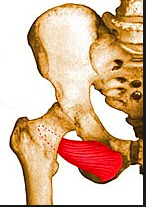
Origin Obturator membrane Insertion Greater trochanter Action Hip abduction (when hip is in flexion) Innervation Nerve to obturator interns |
|
|
Deep group Superior gemellus |
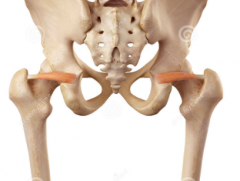
Origin Ischial spine Insertion Greater trochanter Action Hip abduction (when hip is in flexion) Innervation Nerve to obturator interns |
|
|
Deep group Inferior gemellus |
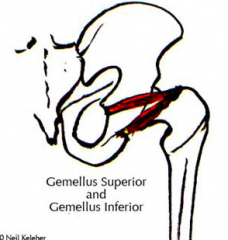
Origin Ischial tuberosity Insertion Greatest trochanter Action Hip abduction (when hip is in flexion) Innervation Nerve toquadratusfemoris |
|
|
Deep group Quadratura femoris |

Origin Anterior to ischialtuberosity Insertion Quadrate tubercle Action External rotation Innervation Nerve to quadrates femoris |
|
|
Hip Hip flexion |
|
|
|
Hip abduction |
Gluteus medius
Gluteus minimus
Gluteus maximus
Piriformis
Tensor fascia latte
Sartorius
|
|
|
Hip Internal rotation |
|
|
|
Hip extension |
Hip extension
Gluteus maximus
Biceps femoris
Semimembranosus
Semitendinosus
Gluteus medius
Adductor magnus
|
|
|
Hip adduction |
|
|
|
External rotation |
|

